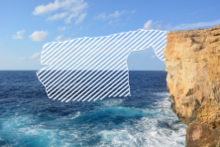Azure Window
The limestone feature, which was in Dwejra Bay close to the Inland Sea and Fungus Rock, was one of the island's major tourist attractions until it collapsed in stormy weather on 8 March 2017.This space devoid of rock then causes tensile stresses that lead to the formation of a vertical joint extending upwards from the notch.Giovanni Francesco Abela's 1647 book Della Descrizione di Malta and De Soldanis' 1746 manuscript Il Gozo Antico-Moderno e Sacro-Profano both mention a Tieqa Żerqa (written archaically as Tieka Szerka)[4] or Għar iż-Żerqa, but this referred to the cave entrance to the nearby Inland Sea.The earliest recorded photographs of the natural arch were probably taken by Richard Ellis, and they are found in an album belonging to Michael Dundon dated 26 July 1879.Four months later a geological and geotechnical report was prepared by consultant Peter Gatt, who represented local firm Geoscience Consulting Ltd, and it determined that the arch was "relatively stable and will continue to remain so for a number of years", and that there was no "imminent" risk of collapse, although it warned that rock falls will continue and it might be hazardous for people to go close to the arch.These comments were made in the wake of an investigation by the Malta Environment and Planning Authority which revealed that explosive material was "probably used" to do rock cutting in the tunnel leading to the Inland Sea.[25][20] Prime Minister Joseph Muscat and Leader of the Opposition Simon Busuttil both tweeted about the collapse of the Azure Window,[26][27] and it also became the subject of many Internet memes on Maltese social media.The San Lawrenz local council urged the government to establish a management plan for the entire Dwejra area, which includes several other notable features despite the loss of the Azure Window.[24] The remains of the arch have formed a number of features which have been called a "divers' paradise", although Transport Malta and the Environment and Resources Authority still advised the public to keep away from the area until surveys and inspections were carried out.[36] The only response to this international call was by Gozitan developer Joseph Portelli, proposing to construct a hotel within a quarry close to the site of the Azure Window.[38] In late 2018, the Russian architect Svetozar Andreev of Hoteì Russia, in collaboration with Elena Britanishskaya, announced a proposal to construct a steel structure on the site of the Azure Window.Entitled The Heart of Malta, the project consists of a structure with polygonal mirrored steel faces, having its size and proportions based on that of the former natural arch.[42][43] However, the project has also been criticized since the area is a marine park and the intervention would destroy the underwater remains of the original Azure Window.[1] The arch was within the Lower Coralline Limestone Formation, a succession of sedimentary rocks that is widespread on the Maltese Islands and was deposited during the Oligocene.





Windows AzureSan LawrenzMaltesenatural archlimestoneInland SeaFungus RockerosionRichard Ellistensile stressesGiovanni Francesco AbelaDe SoldanisDwejra TowerEdward LearMichael DundonUNESCOWorld Heritage SitesYouTubecliff divinglocal timeJoseph MuscatSimon BusuttilInternet memesEnvironment and Resources Authoritylocal councilTransport Maltasedimentary rocksOligocenefossilsfaciesScutellaPectenechinoidforaminiferaOrder of St. JohnWied il-Mielaħ WindowClash of the TitansThe Count of Monte CristoTamil languageVinnaithaandi VaruvaayaThe Odysseyfirst seasonGame of ThronesHugo BossDarwin's ArchLondon Bridge (Victoria)Times of MaltaEuropean CommissionThe Malta IndependentMalta TodayThe Daily TelegraphBBC News OnlineThe GuardianThe Washington PostUSA TodayRecreational dive sitesAkumalAliwal Shoal Marine Protected AreaAliwal ShoalAmed (Bali)Apo IslandApo ReefArrecifes de Cozumel National ParkBay of PigsBelize Barrier ReefBiscayne National ParkBohol SeaBowie SeamountBunakenBunaken National ParkCahuita National ParkCalve IslandCapurganáĊirkewwaCliff Villa PeninsulaCozumelDhilba Guuranda-Innes National ParkEdmonds Underwater ParkEl Ikhwa IslandsFalse BayGħar QawqlaGili IslandsGreat Barrier ReefGreat Southern ReefGuadalupe Island Biosphere ReserveHol Chan Marine ReserveiSimangaliso Marine Protected AreaSodwana BayJohn Pennekamp Coral Reef State ParkKadmat IslandKo TaoLighthouse ReefMantanani IslandsMalapascuaMartin's HavenMarsa AlamMolasses ReefMolokiniNeptune IslandsOsprey ReefPalancar ReefPanglao, BoholPescador IslandPetit Saint VincentPoor Knights IslandsPorteau Cove Provincial ParkPuerto GaleraPunta CanaRas Muhammad National ParkRondo IslandRottnest IslandSan Andrés (island)San Pedro Nolasco IslandShaʽb Abu NuħasShadwan IslandSimilan IslandsSipadanSocorro IslandSound of MullSt. Crispin's ReefTable Mountain National Park Marine Protected AreaTagangaTsitsikamma Marine Protected AreaTubbataha ReefWakatobi RegencyWeh Island